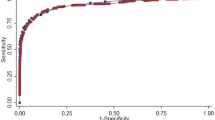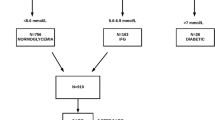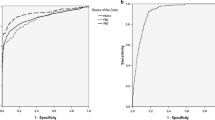Abstract
This study evaluated the use of HbA1c as a screening tool for undiagnosed type 2 diabetes (fasting plasma glucose ≥7.0 mmol/l) in a sample of Cuban-Americans aged ≥ 30 years old. Subjects were randomly recruited from Miami-Dade and Broward counties, FL. Fasting plasma glucose was measured by hexokinase enzymatic method. HbA1c was measured by the DCA2000 + system using the monoclonal antibody method. HbA1c demonstrated a high predictive value in detecting undiagnosed diabetes. The area under the receiver operating characteristics (ROC) curve was 0.87. Also, HbA1c had high sensitivity and specificity when using a cut off value of 6.37 (71 and 86%, respectively). Moderate sensitivity and very high specificity were shown with a cut off value of 6.84 (57 and 96%, respectively). HbA1c is a reliable alternative to fasting plasma glucose in screening for undiagnosed diabetes in Cuban-Americans.



Similar content being viewed by others
References
World Health Organization. Diabetes Mellitus: Report of a WHO Study Group Geneva. Tech Rep Ser No. 727;1985.
Expert Committee on the Diagnosis and Classification of Diabetes Mellitus. Report of the expert committee on the diagnosis and classification of diabetes mellitus. Diabetes Care. 2003;26(1):S5–S20.
Rohlfing CL, Little RR, Wiedmeyer HM, England JD, Madsen R, Harris M, et al. Use of GHb (HbA1c) in screening for undiagnosed diabetes in the US population. Diabetes Care. 2000;23(2):187–91.
Modan M, Halkin H, Karasik A, Lusky A. Effectiveness of glycosylated hemoglobin, fasting plasma glucose, and a single post load plasma glucose level in population screening for glucose intolerance. Am J Epidemiol. 1984;119:431–44.
Guillausseau PJ, Charles MA, Paolaggi F, Timsit J, Chanson P, Peynet J, Godard V, Eschwege E, Rousselet F, Lubetzki J. Comparison of HbA1c and fructosamine in diagnosis of glucose-tolerance abnormalities. Diabetes Care. 1990;13:898–900.
Gerken KL, Van Lente F. Effectiveness of screening for diabetes. Arch Pathol Lab Med. 1990;114:201–3.
Mulkerin EC, Arnold JD, Dewar R, Sykes D, Rees A, Pathy MSJ. Glycosylated hemoglobin in the diagnosis of diabetes mellitus in elderly people. Age Ageing. 1992;21:175–7.
Kilpatrick ES, Maylor PW, Keevil BG. Biological variation of glycated hemoglobin: implications for diabetes screening and monitoring. Diabetes Care. 1998;21:261–4.
Edelman D, Olsen MK, Dudley TK, Harris AC, Oddone EZ. Utility of hemoglobin A1c in predicting diabetes risk. J Gen Intern Med. 2004;19:1175–80.
Selvin E, Zhu H, Brancati FL. Elevated A1c in adults without a history of diabetes in the US. Diabetes Care. 2009;32(5):828–33.
Ko GTC, Chan JCN, Tsang LWW, Cockram CS. Combined use of fasting plasma glucose and HbA1c predicts the progression to diabetes in Chinese subjects. Diabetes Care. 2000;23:1770–3.
Pradhan AD, Rifai N, Buring JE, Ridker PM. Hemoglobin A1c predicts diabetes but not cardiovascular disease in nondiabetic women. Am J Med. 2007;120:720–7.
Droumaguet C, Balkau B, Simon D, Caces E, Tichet J, Charles MA. Eschwege E: the DESIR study group. Use of HbA1c in predicting progression to diabetes in French men and women: data from an epidemiological study on the insulin resistance syndrome (DESIR). Diabetes Care. 2006;29:1619–25.
Inoue K, Matsumoto M, Kobayashi Y. The combination of fasting plasma glucose and glycosylated hemoglobin predicts type 2 diabetes in Japanese workers. Diabetes Res Clin Pract. 2007;77:451–8.
Saudek CD, Herman WH, Sacks DB, Bergenstal RM, Edelman D, Davidson MB. A new look at screening and diagnosing diabetes mellitus. Clin Endocrinol Metab. 2008;93:2447–53.
Flegal KM, Ezzati TM, Harris MI, Haynes SG, Juarez RZ, Knowler WC, et al. Prevalence of diabetes in Mexican Americans, Cubans, and Puerto Ricans from the Hispanic Health and Nutrition Examination Survey, 1982–1984. Diabetes Care. 1991;14(7):628–38.
Harris MI, Klein R, Welborn TA, Knuiman MW. Onset of NIDDM occurs at least 4–7 year before clinical diagnosis. Diabetes Care. 1992;15:815–9.
Harris MI. Undiagnosed NIDDM: clinical and public health issues. Diabetes Care. 1993;16:642–52.
US Census Bureau. Current Population Survey, March 2002, PGP-5. Washington, DC: US Census Bureau, March 2002.
Huffman FG, Knight-Sepulveda K, Mclean M, Zarini GG. Increased adiponectin among Cuban American type 2 diabetics with metabolic syndrome. FASEB J. 2009;23:547.8.
Huffman FG, Gomez GP, Zarini GG. Metabolic syndrome and high-sensitivity C-reactive protein in Cubans. Ethn Dis. 2009;19(2):115–20.
American Diabetes Association. Diagnosis and classification of diabetes mellitus. Diabetes Care. 2008;31:S55–S60.
American Diabetesc Association. Report of the Expert Committee on the Diagnosis and Classification of Diabetes Mellitus. Diabetes Care. 1997;20:1183–97.
Beck JR, Shultz EK. The use of relative operating characteristic (ROC) curves in test performance evaluation. Arch Pathol Lab Med. 1986;110:13–20.
Little RR. Glycated hemoglobin standardization–National Glycohemoglobin Standardization Program (NGSP) perspective. Clin Chem Lab Med. 2003;41(9):1191–8.
Voss EM, Cembrowski GS, Clasen BL, Spencer ML, Ainslie MB, Haig B. Evaluation of capillary collection system for HbA1c specimens. Diabetes Care. 1992;15:700–1.
Selvin E, Crainiceanu CM, Brancati FL, Coresh J. Short-term variability in measures of glycemia and implications for the classification of diabetes. Arch Intern Med. 2007;167:1545–51.
PEW Hispanic Center. Fact Sheet: Cubans in the United States. August 25, 2006. 1615 L Street, NW, Suite 700, Washington, DC 20036-5610. Available online: http://pewhispanic.org/files/factsheets/23.pdf.
Acknowledgments
This research was funded by a grant from NIH/MBRS/SCORE-AC#124401529/42.
Author information
Authors and Affiliations
Corresponding author
Rights and permissions
About this article
Cite this article
Huffman, F.G., Exebio, J.C., Zarini, G.G. et al. Use of HbA1c in Screening for Cuban-Americans with Undiagnosed Type 2 Diabetes. J Immigrant Minority Health 13, 541–545 (2011). https://doi.org/10.1007/s10903-010-9363-3
Published:
Issue Date:
DOI: https://doi.org/10.1007/s10903-010-9363-3




